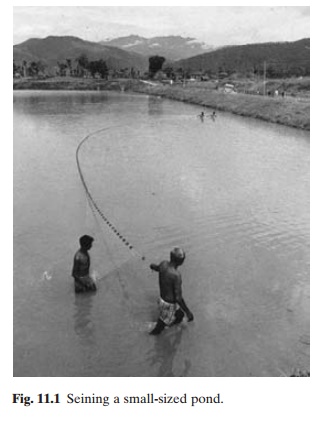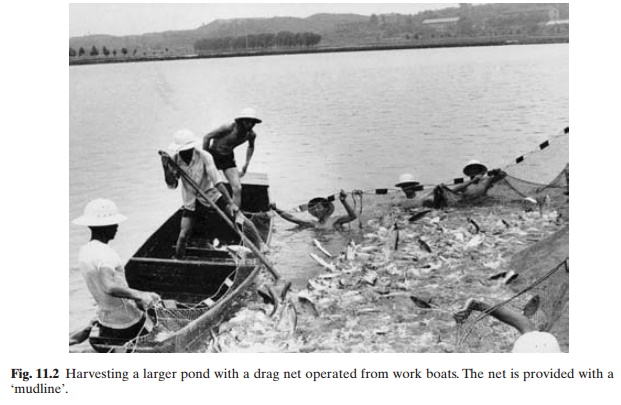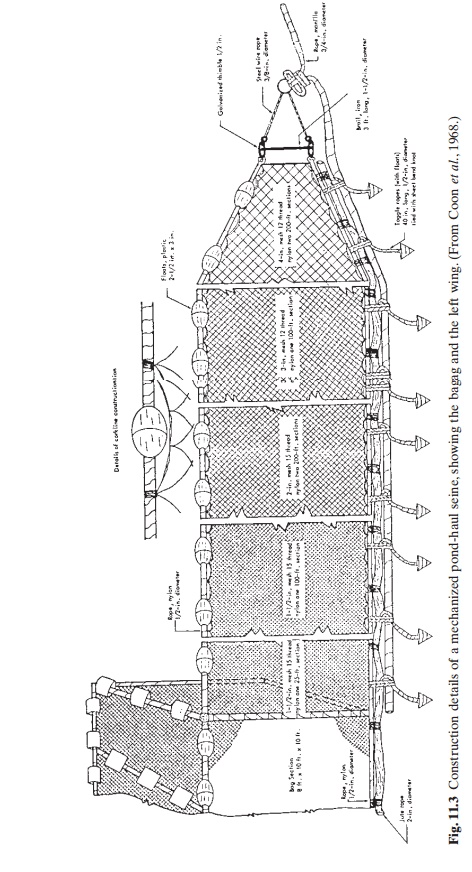Chapter: Aquaculture Principles and Practices: Harvesting and Post-Harvest Technology
Seining undrainable ponds - Harvesting methods in Aquaculture
Seining undrainable ponds
The so-called undrainable fresh-water or brackish-water ponds require pumping to drain. For economic reasons they are drained only very occasionally, if at all. In such cases, and when multiple harvesting and stocking are practised, it is necessary to resort to fishing with commercial fishing gear. The most common fishing equipment for pond farms is a seine net. It is well suited for harvesting most species of fish, although some species like tilapia (e.g. Tilapia aurea) and certain strains of commoncarp can escape the nets by burrowing into the bottom mud. Species like mullets, milkfish and silver carp can escape by jumping the net.
When harvesting is to be done by seining, the shape and size of ponds in farms are designed with this in mind. Usually the length of a seine net is about one and a half times the width of the pond and the depth about two to three times the pond depth. A preferred and economic length is not more than about 150m. The mesh size of the net depends on the size of the animal to be harvested. Too small a mesh will make dragging the seine more difficult due to increased resistance in water and so a larger mesh size is preferred when the size of the animal permits it. In nursery ponds smaller-meshed seines, even ones made of mosquito nets, are used but then the smaller pond dimensions enable easy fishing. Generally, wooden brail poles are attached to both ends of the seine for convenience in pulling and keeping the net stretched vertically (fig. 11.1). The poles can be used for attaching hauling lines, when mechanized equipment is used. The head line has floats made of cork, styrofoam or other suitable floating material and the lead line has lead sinkers or lead cores. Traditional lead lines have a tendency to sink into muddy bottoms and allow the net to roll up, resulting in loss of animals caught in the net. To avoid this, the use of ‘mud lines’ is recommended. They consist of a number of relatively thin ropes tied loosely together, made of a material (such as jute or cotton) that readily absorbs water. Mud lines skid on the bottom, without digging or lifting the mud. This reduces escape under the seine (fig. 11.2). Hepher and Pruginin (1981) described the use of a bunch of synthetic strings, bound together to form a thick band for attachment to the bottom line of seines, to prevent the line from sinking into the mud. They reported that a similar result can be obtained when polyethylene strips of about


20cm width and 40cm length are attached to the bottom line. The strips should be folded over the line so that they stretch about 20cm behind the line. To prevent the escape of fish that jump over the net, the head line is propped up using large floats.
When dragged, the seine bows out creating a shallow bag for the catch.To increase the capacity, the central part of the seine can be made deeper so that it forms a deeper sack during operation. To increase the capacity further, and reduce escape, the seines can be equipped with special bags. Coon et al. (1968) described a mechanized haul seine system (fig. 11.3) which consists of two wings and a bag. The wings are composed of six sections of various length and mesh sizes. Large-sized meshes are used in the leading wing sections to reduce resistance to drag. The sections are joined together by shackles or cordage. Perpendicular breast lines at the ends of the adjoining sections are laced together. Bridles and brails attached to the edge of each wing keep the seine wings open vertically and are also used for attaching the

hauling lines. Jute rope, which soaks up water, is attached to the bottom line of the wings and the bag and it keeps the bottom line down without digging into the mud during operation. The bag section has the same small mesh size as the adjoining sections of the wings.
The type of seine proposed by Coon et al. needs a pontoon-type barge for carrying and setting it, and a mechanical seine puller for hauling the net. In smaller ponds seining is generally done manually (see fig. 11.1). The water level is reduced by partial drainage to concentrate the animals, making their capture easier. Seining generally starts at the deeper end of the pond and ends at the shallow part. Dragging the net without allowing it to rise requires skill and an experienced crew. It is better to use trucks or tractors for hauling when large nets are operated. Special winches can be fitted to the vehicles for this purpose. After reaching the shallow end of the pond, the net has to be closed in and raised to the embankment with the catch (see fig. 11.2). It is comparatively easy when the seines have detachable bags, as in the mechanized seines described by Coon et al. In unmechanized seines, considerable labour is involved if the catch is substantial (fig. 11.4), so different types of lifting devices have been developed. Mechanized dip nets are commonly used in large farms, but need two or three men to operate them. Another device used is a mechanized bucket elevator, but it can be installed only on a well-built concrete structure.

Purpose-built conveyor belts, similar to ordinary grain conveyors but with soft rubber belts and covers, are efficient to use, especially when the fish have to be lifted to a high elevation (fig. 11.5).The lower hopper of the belts can be filled by hand, by mechanized dip nets or by air-lift pumps. In order to avoid any injuries to the fish and to improve product quality, specially designed fish screws for lifting fish with water have been devised. The internal spiral ribbon and the pipe housing that revolve together lift up water along with the fish, in the space between the two. Different types of centrifugal fish pumps used in marine fishing have been tried in fish farms, but because of the damage to harvested fish they are not very widely used. Special air-lift pumps can lift the fish without

Related Topics